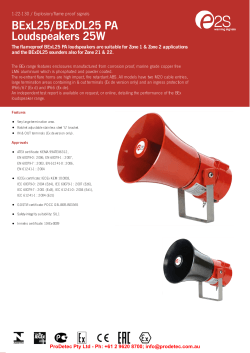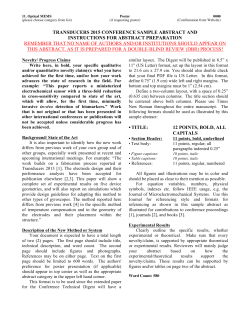
Flyer: tecsis force transducers for explosion hazard zones.
2 1 0 B075 5001 B013 3001 B013 3501 B013 3101 B013 3511 B081001 B082 2001 F23011510456 F13521410001 F32101412001 F12701414001 F12701415001 F12701416001 P2325B075001 P3276B013001 Preisliste ’09 $ 3 With ATEX and IECEx approval n n C Bajone -R de -p lig g g r > a dere tecsis force transducers Preisliste ’09 for hazardous areas. Kraft Druck Temperatur Schalten Service tecsis force transducers for explosion hazard zones. ATEX- and IECEx-approval: the safe solution. Whether offshore or on land, gas or oil industry, mining or other dusty environments: The equipment and safety systems used in explosion hazardous areas must be certified and marked. This also applies to force transducers, since primary explosion protection is not always possible. With tecsis transducers you are on the safe side. Thanks to the approvals granted to us, we are able to furnish uninterrupted chains of evidence: from the materials used, through the manufacturing process. From inspection up to approval. Classification of hazardous areas and approvals for tecsis force transducers in hazardous zones according to ATEX and IECEx: Gases Zone 1 2 ATEX (Europe) ✔ IECEx (international) 22 ✔ ✆ ✆ ✔ ✔ ✔ ✆ ✆ ✔ FM (NEC 505-7) (USA) ✪ ✪ — — — CSA (CEC 18-006) (Canada) ✪ ✪ — — — ✪ in progress 20 Mining 21 ✔ available 0 Dusts M1 M2 ✆ on request — According to NEC and CEC not defined for North America Classification of hazardous areas in North America: gases as an example Class 1: Gases, vapors, mist (the plant operator selects classification division or zone) tecsis: highest safety. NEC 505-5 / CEC J18-004: Classification of divisions NEC 505-7 / CEC 18-006: Classification of zones Systems and components from tecsis Division 1: An explosive atmosphere is present continuously or occasionally under normal operating conditions. Zone 0: An explosive atmosphere is present continuously and over long periods. places where the highest safety Zone 1: An explosive atmosphere is present occasionally under normal operating conditions. ✔ expertise in development, we are able Division 2: An explosive atmosphere Zone 2: An explosive atmosphere occurs occurs rarely and only for a short time rarely and only for a short time under under normal operating conditions. ✪ normal operating conditions. ✔ are in use worldwide: in all those matters. Thanks to our high level of to find optimal solutions – even in unusual applications and highly specialised fields. Amongst our customers are leading corporations as well as small busi- This classification into zones, as an example, applies for storage tanks and analogously for tanker trucks or other hazardous zones. The zone classification is similar for combustible dusts (from 20-22). The assessment of the risk for an explosion and zonal classification is to be carried out by the plant operator. The plant operator selects the accepted approval. nesses, which we support worldwide through local offices. If you want to meet high safety-related standards most reliably, then we are the right partner for you, too! Approvals required and zone classification by country and region Country/Region Required Approvals Zone classification Europe ATEX 94/9/EG (Atmosphere Explosive) According to ATEX (CENELEC) (European Committee for electro technical standardization) Oil and gas: 0 / 1 / 2 Dust: 20 / 21 / 22 Equipment group I Mining: Category M1 and M2 USA FM (Can also be done by UL) ✔ hazardous classified loacations acc. to NEC 500 (or 505) (National Electrical Code) For Gases Vapors Mist: Class I Division 1 and 2 or Zone 0 / 1 / 2 (In 1996, the US introduced the IEC classification system additionally to the existing system for Class I. This change was made by Article 505 of the NEC, enabling users to select the optimal system from a technical and economic point of view. For Dust: Class II Division 1 and 2 Fibers and threads: Class III Division 1 and 2 (Division 1 demands are similar to Zone 0 bzw. 20) ✪ Canada CSA ✪ According to CEC J18 (as USA) South Africa IECEx ✔ According to IECEx (as Europe) Australia New Zealand IECEx India IECEx and FM accepted ✔ According to IECEx (as Europe) ✔ According to IECEx (as Europe) China NEPSI on request Russia GOST R GOST R 51330-99 Zone classification as IECEx Zone 0/1/2 South America Brazil IECEx ✔ Suitable types of protection for tecsis force transducers Zone According to IECEx (as Europe) Typical product identification. Types of protection Ex i Ex i Ex d Ex m 1 ✔ ✔ ✔ 2 ✔ ✔ ✔ II 2G Ex ib IIC T4 -25°C<Tamb<85°C Ex m II 2G Ex mb IIC T6 -40°C<Tamb<60°C 0 ✔ available „Ex i“ (Intrinsic safety) „Ex d“ (flame proof enclosure) and „Ex m“ (encapsulation) +Purely electronics-based type of protection: other +Purely enclosure-based type of protection: protective measures are not necessary, similar on the housing +Plug connections permitted: limited voltage and current values prevention spark formation no electronics-based protection necessary + No power limitation +No isolated supply unit necessary +Suitable for gas and dust zones -Force transducers are part of the enclosure, +Suitable for gas and dust zones + Globally recognized and accepted ignition protection so a separate approval is required for each + Suitable for all geometries geometry - Operation permitted only with isolated supply units - Does not have the same status worldwide as „Ex i“ -Plug connections are not permitted: no power limitation specified - Suitable only for specific geometries Force transducers from tecsis: a wide range of uses. Deliverable worldwide: Force transducers for any application. At tecsis you will find a comprehensive range of products. Our force transducers with thin-film technology or standard strain gauges are approved for use in hazardous zones. F13C1 Compression transducers F23CA Tension-/Compression transducers F23C1 Tension-/Compression transducers F53C1 / F53C8 Load pin The persuasive product features: • ATEX and international IECEx approval • FM (USA) and CSA approval (Canada) in preparation for zones 1 and 2 according to NEC 505-7 and for division 2 (according to 505-5 (in Class 1 = gases)) • Nominal load from 1 kN up to 10,000 kN • Integrated amplifier (Ex i = 4… 20 mA; Ex d = 4… 20 mA or 0… 10 V or CAN output) • D epending on the version between -40°C und +100°C ambient temperature suitable •F or temperature classes up to T6 and Explosionsgroup IIC •S uitable for zones 1 and 2 (optionally 0, 20, 21 and 22) • With standard strain gauges or thin-film sensors for excellent long-term stability, reliable and precise force measurement – whilst taking up minimal space • Can be supplied with different geometries tecsis – where safety counts. tecsis Systems and components: Our products help you to achieve highest safety. tecsis GmbH Carl-Legien-Straße 40–44 D-63073 Offenbach am Main Telefon: +49 (0)69 5806-0 Telefax: +49 (0)69 5806-7788 E-Mail: info@tecsis.de Internet: www.tecsis.de SE 942 04/2012 Bildnachweis: tecsis GmbH Please contact us: We will be happy to advise you. Visit us: www.tecsis.de
© Copyright 2025











